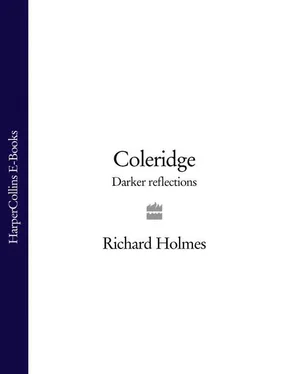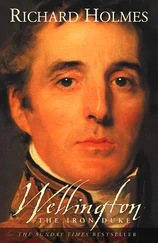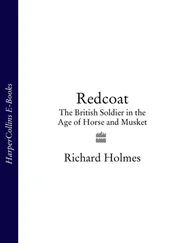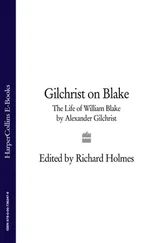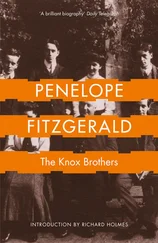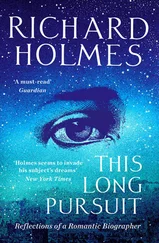There was now much confusion in Naples, and Coleridge was not after all “franked home” with official papers by Elliot. So instead he made a leisurely expedition into Calabria with Captain Pasley. He visited Virgil’s tomb and contemplated Vesuvius. In late December he was offered a carriage-trip to Rome, for a fortnight as he supposed, and leaving his boxes of books and papers with an embassy friend, set out on Christmas Day. Almost immediately on his arrival, he heard from Mr Jackson, the English consul, of the battle of Austerlitz and the French armies sweeping southwards into Italy. “To stay, or not to stay?” he noted calmly. He decided to stay, and once again found himself marooned by circumstances. He made no attempt to continue his journey until the spring, and still he wrote no letters home.
The absence of news frightened the Wordsworths and infuriated Southey. Dorothy wrote to Lady Beaumont on Christmas Day: “Poor Coleridge was with us two years ago at this time…We hear no further tidings of him, and I cannot help being very uneasy and anxious: though without any evil, many causes might delay him; yet it is a long time since he left Malta. The weather is dreadful for a sea voyage. O my dear friend, what a fearful thing a windy night is now at our house! I am too often haunted with dreadful images of Shipwrecks and the Sea when I am in bed and hear a stormy wind, and now that we are thinking so much of Coleridge it is worse than ever.” 162
The truth seems to be that Coleridge, with plenty of money and several letters of recommendation and credit, was embarked on a leisurely tour of the Roman sites and galleries. *One long note on the Spanish Steps suggests that he was staying in the English quarter beneath the Trinita dei Monti (where Keats would die of tuberculosis sixteen years later). Rather than face the prospect of England, he had decided to risk capture by the French armies who were steadily descending through northern Italy. While most English visitors fled back to Naples, and General Craig’s expedition sailed ignominiously back to Sicily, Coleridge was quietly making notes on the Last Judgement in the Sistine Chapel. “Ideal = the subtle hieroglyphical felt-by-all, though not without abstruse and difficult analysis detected & understood…Take as an instance of the true Ideal Michel Angelo’s despairing Woman at the bottom of the Last Judgement.” 163
Captain Pasley, who had also pulled back with his regiment to Sicily, wrote to a fellow-officer, “I was happy to meet our friend Coleridge at Naples, certainly few men are more interesting. He is now at Rome, where he stayed. Not withstanding advices of the English Resident there [Jackson] to retire, I hope the poet’s eye in a fine frenzy rolling may never contemplate the roof of a French prison: but from his natural indolence I cannot be too sanguine of his taking himself off in time.” 164Coleridge’s book box was also shipped back, and eventually finished up where it had started, in Valletta with Stoddart. Coleridge was alone with his shirts, his guidebooks, and two remaining notebooks, in the Eternal City.
It seems to have suited him very well. Within a matter of days he had introduced himself with great success into the circle of two notable expatriate groups, one literary and the other painterly, who frequented the artistic quarter round the Spanish Steps. The first was a group of German writers who gathered at the splendid residence of Wilhelm von Humboldt, directly overlooking the Trinita dei Monti. Humboldt was a distinguished young diplomat in his mid-thirties, brother of the famous South American traveller. He had been appointed Prussian Minister to the Court of Pius VII, and held a salon with many German university visitors where Coleridge, an honorary graduate of Göttingen, immediately felt in his element.
Humboldt had formed a life-long friendship with Schiller at Jena University, and developed advanced theories of linguistics and philology, publishing learned papers on Basque and Javanese dialects. His notion of a “language world” was calculated to appeal to Coleridge, and his famous binary concept of “the Dual” (as opposed to two singulars and/or a plural) was much in Coleridge’s metaphysical style. Humboldt later championed ideals of “academic freedom”, and helped to found Berlin University. He was a patron of both arts and sciences, and among his protégés at the Trinita dei Monti was the brilliant young Romantic poet and critic, Johann Ludwig Tieck.
Coleridge formed an animated friendship with Tieck, discussing Goethe and A. W. Schlegel, and the latest philosophical work of Schelling (who had also been a professor at Jena) which they compared with that of the mystic Jacob Boehme. It was probably now that Coleridge first came to grips with Schelling’s System of Transcendental Idealism (1800), which rekindled his ambition to write his own general philosophical treatise at some later date. Tieck’s sister, Sophie Bernhardi, later wrote to Schlegel of the remarkable Englishman at Rome, who knew so much current German literature and who admired Schlegel’s own work on Shakespeare “unbelievably so”. Coleridge in turn admired Tieck, translated one of his poems, 165greatly valued his hospitality and “kindness”, and met him again years later in London with fond recollections of their Roman hours together. 166
But Coleridge’s real intimacies were formed in the more bohemian circle of the painters. At the Cafe Greco on Strada de’ Condotti he fell in with a group that included George Wallis, Thomas Russell, and the 27-year-old American artist Washington Allston. Russell was an art student from Exeter, and Wallis a Scottish landscape painter travelling through Italy with his family, including a ten-year-old son grandly named Trajan Wallis, who delighted Coleridge with his precociousness. But it was Washington Allston, a dreamy young man, elegant and aristocratic, with wild black hair framing a pale abstracted face, to whom he most instinctively warmed.
Allston had grown up on a cotton plantation in South Carolina, and had the slow finesse of a Southern gentleman. Moneyed and leisurely, he had attended Harvard and gone on to study art in Paris and at the Royal Academy in London, where he knew Fuseli and Benjamin West. Melancholy and amusing, he said he had received his imaginative education through the stories of the black plantation workers, tales of “barbaric magic and superstition…ghosts and goblins…myths and legends to startle and alarm”. 167He had a “tendency towards the marvellous” and loved to stay up all night talking. A friend said Allston could never paint the reflections of dawn sunlight on water, because he had never seen a sunrise.
Naturally, Allston espoused the Sublime school of painting, with its brooding landscapes and dramatic subjects. He preferred Gothic to Greek, and his beau-ideal was Titian and Veronese with their rich colours and mysterious allegories. He had painted scenes from Schiller’s plays, Mrs Radcliffe’s novels, Milton’s Paradise Lost , and the Bible. The latter characteristically included “St Peter When He Heard the Cock Crow”. Leaving a fiancée behind in Boston, he had come to Rome in 1805, renting a studio by the Borghese Gardens, and a rustic summer lodging up in the Roman hills at Olevano.
One of the first things Coleridge ever heard him say was that a fellow-painter was too realistic and down to earth. “He works too much with the Pipe in his mouth – looks too much at the particular Thing, instead of overlooking – ubersehen. ” Allston valued the ideal above all else, and Nathaniel Hawthorne would later put him into a short story to illustrate this quality pursued to excess, “The Artist of the Beautiful”. Like Coleridge, he had trouble finishing his work, and he was to spend over twenty-five years on his last canvas, a monumental picture of “Belshazzar’s Feast”, which was unfinished at his death.
Читать дальше
